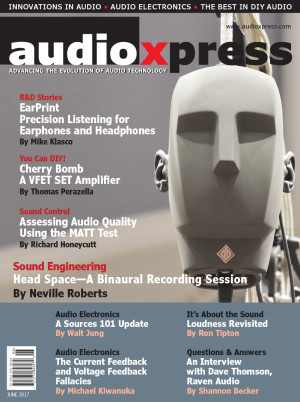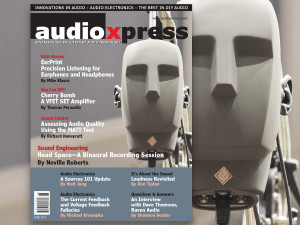 If you have a passion for high-quality audio experiences you know this is a continuous learning process. In audioXpress June 2017, you will learn more about binaural recording, how you can tune your listening to your own hearing when using earphones and headphones, and we explain how to assess audio quality in any acoustical environment with the MATT Test. And for those serious about audio electronics and amplifiers, we have articles from Walt Jung, Michael Kiwanuka, and Tom Perazella. Learn more about loudness and how Raven Audio is building a thriving business with high-quality tube amplifiers. That and much more is now available in audioXpress June 2017.
If you have a passion for high-quality audio experiences you know this is a continuous learning process. In audioXpress June 2017, you will learn more about binaural recording, how you can tune your listening to your own hearing when using earphones and headphones, and we explain how to assess audio quality in any acoustical environment with the MATT Test. And for those serious about audio electronics and amplifiers, we have articles from Walt Jung, Michael Kiwanuka, and Tom Perazella. Learn more about loudness and how Raven Audio is building a thriving business with high-quality tube amplifiers. That and much more is now available in audioXpress June 2017.Featured on the cover of audioXpress June 2017 is a Sound Engineering article by Neville Roberts, following an historical studio session using binaural - or “dummy head” - recording. In “Head Space,” Roberts describes how UK-based record label Chasing The Dragon decided to produce binaural recordings to investigate this format and compare it against more conventional recording techniques. The company is using a Neumann KU-100 binaural head with recordings of the same performances made simultaneously using a conventional multi-microphone setup feeding a mixing deck to produce a conventional stereo mix. They digitally recorded the stereo mix signals on two channels at 24 bit/192 kHz PCM as well as at the “double DSD” rate of 5.6 MHz, while at the same time recording the binaural signal on another two channels. The result, a new binaural direct-to-disk LP entitled “Espãna,” is a tribute to Spain and includes pieces by Rimsky Korsakov, Bizet, and Chabrier. The recordings are also available as digital downloads in studio-master quality 24 bit/192 kHz PCM and DSD via the Chasing The Dragon website at www.chasingthedragon.co.uk.
Chasing The Dragon has kindly made available two 1 min 30 second excerpts from the Chabrier’s “Espãna” recording as a studio master 24 bit/192 kHz PCM file. This provides a unique opportunity to directly compare a conventional stereo recording against a binaural recording of the identical performance. The first excerpt is taken from the conventional stereo mix and the second from the binaural recording. audioXpress readers can access the recording on streaming here or download it from here by right-clicking on the filename and selecting “Save target as…”
In R&D Stories, Mike Klasco writes about Earprint – Precision Listening for Earphones and Headphones. In his report for audioXpress, Klasco interviewed the masterminds behind the patent-pending process Even EarPrint technology (five patents filed to-date with more on the way), which measures the user's reactions to a series of eight different frequencies in each ear, based on the industry-standard “threshold of hearing test” used by Audiologists and extending it to better fit the music spectrum. This allows correcting earphone and headphone responses each time we put them on, taking only 90 seconds.
In “A Sources 101 Update,” Walt Jung revisits his “Sources 101” article published in audioXpress, April and May 2007, which are available on the audioXpress website. Those articles originated several follow-on letters from September of that year, discussing the basic test methodology and the relative validity for some specific current source types. In this article update Jung tries to clarify some semantic terms, revisits the basic test methodology and the relative validity for some specific current source types.
Also on the topic of audio electronics and audio amplification, Michael Kiwanuka writes about “Current Feedback and Voltage Feedback Fallacies,” explaining why he thinks the terms are misconceived and inaccurate. In the article, Kiwanuka demonstrates that the correct application of these terms is entirely dependent on the manner in which major loop feedback is applied around the forward-path of an amplifier, irrespective of the workings of its internal circuitry.
In Sound Control, Richard Honeycutt looks at “Assessing Audio Quality Using Musical Articulation Test Tones (MATT).” Honeycutt discusses how acoustical engineering should explore parameters such as speech intelligibility, reverberation, energy ratios, clarity, definition, and other key measurements to identify audio quality issues and obtain the highest quality sound possible from the components in any listening environment.
In a completely new article series about Sound Reproduction, Ron Tipton now writes about perceived volume in “Loudness Revisited: Part 1. As he explains: “Now that media streaming has become a preferred way, among many people, of listening to music, we all want to avoid the need to constantly adjust the volume control. Loudness normalization, the attempt to avoid having to adjust the volume, has become desirable, if not a true necessity.” In this first article, he addresses the roots for loudness standards and how it all started with volume control.
For our DIY readers, this edition includes a nice amplifier project by Thomas Perazella. His Cherry Bomb VFET SET Amplifier project was inspired after discovering a rare Yamaha 2SK77 VFET transistor. As Perazella says, “One of the great things about doing a DIY project is that the only one you have to please is yourself. In fact, we should coin a new acronym, DIFY meaning Do It For Yourself. This project is the epitome of that philosophy.”
Also in this edition, Shannon Becker conducts an interview with Dave Thomson, CEO and founder of Raven Audio, a tube amplifier company based in Texas, which has successfully created a thriving business with high-quality tube amplifiers and preamplifiers. Since it was founded in 2010, Raven Audio never stopped growing and now offers a complete range of products and just opened a new facility in Onalaska on Lake Livingston, 100 miles north of Houston, and continues to expand its engineering staff.
 Finally, in this month’s Hollow State Electronics, Richard Honeycutt discusses “Power Supplies for Hollow-State Guitar Amplifiers.” Honeycutt reviews the topologies and designs of power supplies since the introduction of hollow-state guitar amplifiers by George Beauchamp in the late 1920s, the changes from tube rectifiers to solid-state diodes in the late 1950s, and looks at some of the power-supply circuits that amp makers have used along the way.
Finally, in this month’s Hollow State Electronics, Richard Honeycutt discusses “Power Supplies for Hollow-State Guitar Amplifiers.” Honeycutt reviews the topologies and designs of power supplies since the introduction of hollow-state guitar amplifiers by George Beauchamp in the late 1920s, the changes from tube rectifiers to solid-state diodes in the late 1950s, and looks at some of the power-supply circuits that amp makers have used along the way.All this is available on audioXpress June 2017, now available to access and download online. Just visit: www.gotomyxpress.com
Of course you can also subscribe here: www.audioxpress.com/page/audioXpress-Subscription-Services.html
And you can also buy a single printed issue or the complete audioXpress issue archive on USB at www.cc-webshop.com


